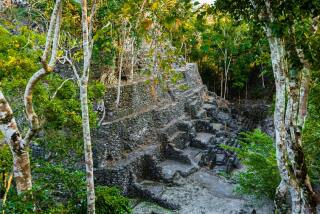Digs Unearth Hoard of History on Egyptian Pyramids
- Share via
GIZA PLATEAU, Egypt — A year of digging at one of the world’s great archeological sites has given Egyptologists a much broader view of life, and death, in the age of the pyramids.
Years of questions about how much of that world was left have been replaced by so many relics, so many pieces of the pyramid puzzle, that archeologists are hard put to keep up.
Cheops, who built his Great Pyramid on Giza Plateau 4,600 years ago, is no longer among ancient Egypt’s most mysterious figures, nor are the workers who lived and died in the shadow of his monument.
“It’s one surprise after the other,” said Zahi Hawass, who is in charge of the pyramids area and the Sphinx. “Each find has been a shock.”
Here are some of them:
* A vast city of 200,000 workers, earliest and largest of its kind, that stretched 2 miles from the base of the Sphinx. Archeologists have found parts of houses, furniture, even seeds of garden plants.
* A cemetery for foremen, workers and their families. One hundred tombs have been unearthed so far, 10 of them under small pyramids. They contain statues, bits of offerings and tablets inscribed to illustrate the owner’s work. The many skeletons with bent spines tell experts the work was indeed harsh.
* A business area from what Hawass believes was a workers’ village. It is next to the cemetery and may be part of a complex including a residential area, businesses and a burial ground. Finds range from bread molds to discarded food.
Each of the three excavations is helping rewrite whole chapters about the Old Kingdom, a 441-year period ending in 2134 BC, whose Pharaohs dotted the desert heights along the Nile Valley with their pyramids.
Many royal relics appear to have been destroyed during a popular uprising 400 years after the death of Cheops in 2528 BC.
Over ensuing centuries, tons of sand buried the cemetery and business center in a basin 3 miles from the Sphinx. The remains of the entire ancient city sprawl beneath Nazlett el-Sammen, a modern tourist village at the statue’s feet.
Hawass said experts can picture for the first time how the landscape appeared just after the Great Pyramid was built.
That event ushered in a period of 70 years when Giza Plateau hummed with construction, first of Cheops’ monuments, then those of his son Chephren, and finally of the pyramids and temples built by his grandson Mycerinus.
“All the monuments are in place,” Hawass said. “We know the route of a great causeway that led from the pyramid to Cheops’ Valley Temple, 810 meters away. We know where the city was, where the harbor was. We know where the king’s palace and great royal farms should be.”
Because of the year’s digs, Egyptologists know the meaning of a massive wall that had stumped them for years: It separated the divine realm of the Pharaohs from the everyday world of the workers, now being excavated.
The harvest of information includes the physical characteristics and medical histories of workers, what they ate and drank, how they lived and were buried.
“Ancient Egyptians loved to have fun, entertain, drink beer and wine, sit in gardens,” Hawass said.
“We knew this from tomb paintings, but now we know it because of our excavations. We’ve found headrests for their beds. We’re looking in detail at their diet. We found the skull of a man who died after brain cancer surgery, the first one on record.”
Occasional finds in Giza’s sands have tantalized archeologists for generations: a worker’s tool, pottery shards, bits of the processional causeway over which Cheops’ body was carried to his pyramid.
Then, in the late summer of 1990, an accidental discovery led excavators to a long-buried cemetery for the Pharaonic middle class.
At about the same time, work began on trenches for a U.S.-financed sewage project in the tourist village. Artifacts surfaced everywhere the dirt flew, and the Persian Gulf crisis allowed archeological teams to work without fanfare.
Mark Lehner of the University of Chicago Oriental Institute is co-director with Hawass of excavations at the workers’ village. It is surprisingly similar to Deir el-Medina, a village for workers who dug and decorated royal tombs 1,000 years later in the Valleys of the Kings and Queens opposite modern Luxor in southern Egypt.
Lehner said the Giza workmen’s area tells the story of the pyramid age.
“Workers came here to build the monuments and stayed during the ages when the cult of Cheops existed.” he said, but after a few centuries, “there were only a few priests to carry on the rituals.
“There was no work, no reason for people to stay. The area disappeared beneath the sand.”
More to Read
Sign up for Essential California
The most important California stories and recommendations in your inbox every morning.
You may occasionally receive promotional content from the Los Angeles Times.












